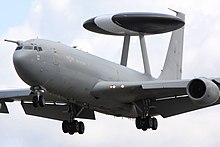Radome
[2] In addition to radar protection, radomes on aircraft platforms also act as fairings that streamline the antenna system, thus reducing drag.
When found on fixed-wing aircraft with forward-looking radar, as are commonly used for object or weather detection, the nose cones often additionally serve as radomes.
On airborne early warning and control (AEW&C) aircraft (e.g. the American E-3 Sentry), a discus-shaped rotating radome, often called a "rotodome", is mounted on the top of the fuselage for 360-degree scanning coverage.
On fixed-wing and rotary-wing aircraft using microwave satellite for beyond-line-of-sight communication, radomes often appear as bulged "blisters" on the fuselage.
A foldback circuit can act to prevent this; however, one drawback of its use is that it causes the station's output power to drop dramatically, reducing its range.
Many tower sites require or prefer the use of radomes for wind loading benefits and for protection from falling ice or debris.
For radar dishes, a single, large, ball-shaped dome also protects the rotational mechanism and the sensitive electronics, and is heated in colder climates to prevent icing.
The RAF Menwith Hill electronic surveillance base, which includes over 30 radomes, is widely believed to regularly intercept satellite communications.
Large cruise ships and oil tankers may have radomes over 3 m in diameter covering antennas for broadband transmissions for television, voice, data, and the Internet, while recent developments allow similar services from smaller installations such as the 85 cm motorised dish used in the SES Broadband for Maritime system.




